-
 The Leak Trough-Line Tuner a History.
The Leak Trough-Line Tuner a History.
The Leak Trough-Line Tuner....a milestone in tuner design.
Its hard to imagine a time when both FM broadcasting and Stereo radio did not exist, but back in the 1950's that was the case. Many audio and radio enthusiasts waited for the first FM radio broadcasts, which promised better sound quality and greatly reduced background noise over MW/LW and SW radio broadcasts, with great anticipation.
The BBC were developing this technology with help from units supplied by a company called STC. STC had supplied a number of FM tuners to the BBC so that they could run research on reception conditions as part of ongoing FM trials. A British company called Leak were among/if not the first commercial audio company to get their hands on an STC unit, which allowed Leak to demonstrate FM with its products at shows. However not being satisfied with this Leak decided to develop their own FM tuner.
1954 was the year that Leak embarked upon this period of FM tuner development. Ted Ashley, Stan Amos, G C Johnson ( Amos and Johnson were BBC engineers who worked for Leak )and Leaks owner Harold Leak oversaw the project. After a year of work the fist FM tuner was launched onto the UK market...it was called the Trough-Line. The name was derived from an aspect of the design, namely the tunning element.

The biggest difficulty the Leak design tean encountered was providing a design which did not drift of station due to changing temperature within the FM circuit. This part of FM tuners is known as an oscillator and the high temperatures found in valve designs would change the shape of the oscillator slightly and thus it would loose stability, resulting in drift. Many FM designers used AFC (Automatic Frequency Control) to compensate but large quantities had to be used and this led to poor tuning functionality. Excessive AFC meant you just did not really know what frequency the tuner was set to. This was unacceptable to the Leak design team so they set about dealing with these major issues. The solution was pure genius “ a shortened quarter wavelength transmission line could act in place of a conventional coil inductance used in ordinary radio oscillators. This quarter wavelength transmission line was made in the form of an open trough, square in section, with the side facing downwards. In the centre of the trough, a conductor ran along the length, with various taps that connected into the circuit of the oscillator valve and tuning capacitor. This transmission line is almost impervious to the effects of heat and so the oscillator frequency remains inherently stable”(1). It was this design solution that gave the Leak tuner its distinctive name, the Trough-Line.
In the early days of FM the frequency range you could tune to was very limited starting at 88 MHz and ending at 100 MHz (totally useless today as modern FM stretches to 108) however in its day the first Leak Trough-Line was a breakthrough, and had all the tuning range that was required. This gave Leak a FM tuner (The VS was an AM Leak tuner already available) for its audio range in 1955. The unit was stylish but very bulky and heavy,this was due to the use of copper in the trough. The massive amount of copper used also made the mk1 tuner very expensive to make. One change in the design which was added in order to meet very stringent specifications and was discovered during quality control tests was that a little AFC was required. With this addition the Leak tuner had the most stable tuning characteristic of any FM design at the time.
One other addition to the design which was unique among its contemporary tuners (and worth noting if you plan to buy vintage FM/AM tuners from this time period), the Trough-Lines were self powered. Every other design on the 1950's market had to be powered via a power outlet on a pre-amplifier or power amplifier. In its day this was a radical design choice as it allowed Leak tuners to be used anywhere and with other product ranges as well. Being self powered also makes the Trough-Line ideal for purchase today.
The first tuner has a volume control on the left side of the fascia and a tune dial on the right, the AFC switch is on the rear of the unit, later tuners had this on the front. This model was available from 1955 to 1959.
Front view of the first Leak Trough-Line FM Tuner

Rear view of above

With the change in fascia design from gold enameled steel to the later diakon plastic and a more art deco look to match new products in the Leak range the opportunity was taken to improve the design both visually, functionally and in overall design terms. The Trough-Line 2 was put into production in 1960. This new tuner was different in a number of ways to the preceding model, it had the AFC control on the front panel (which could be defeated), a local and distant selector for sensitivity, increased tuning range from 88Mhz to 108Mhz, and on the back panel a FM Multiplex output.There were changes to the internal layout and design as well. The solid copper oscillator tube was replaced with a copper plated (possible because of skin effect conductivity is mostly on the outer surface) mild steel tube, this reduced weight and costs. However this change introduced a problem at the calibration stage. Each unit had to be measured to insure that the oscillator voltage was correct and only then could alignment happen. If the plating or solder was off then the Q of the oscillator trough would be off and influence the performance for the worse...the change in materials used to produce the trough between the mk1 and mk2 complicated set up slightly.
The Art Deco styled Trough-Line 2 FM Tuner using diakon plastic for the fascia

Internal view

Ted Ashley with Amos and Johnson acting only in an advisory role were responsible for the changes between the mk1 and mk2. Valve complement changed slightly with the above mention functional changes also adding greatly to the usability of the tuner. These changes are important as they make the Trough-Line into a tuner that can be and is well suited to modern use....Leak were a head of their time.
At the time of the Trough-Line mk2 a decision had not nationally been made about the standard for FM stereo decoding so the output on the back panel would allow the unit to be upgraded when suitable models were available, from Leak or other manufacturers. This feature allows the contemporary user/collector to upgrade a mono tuner to stereo one using either a solid state device or a valve one such as the decoder from EAR. The Trough-Line sounds excellent in my opinion in mono as well.
Rear of the Trough-Line 2. Note the Multiplex output socket on the right. This was for the hook up of an external stereo decoder. Audio out was via a single fixed cable terminated with a phono plug and aerial connection was via screws
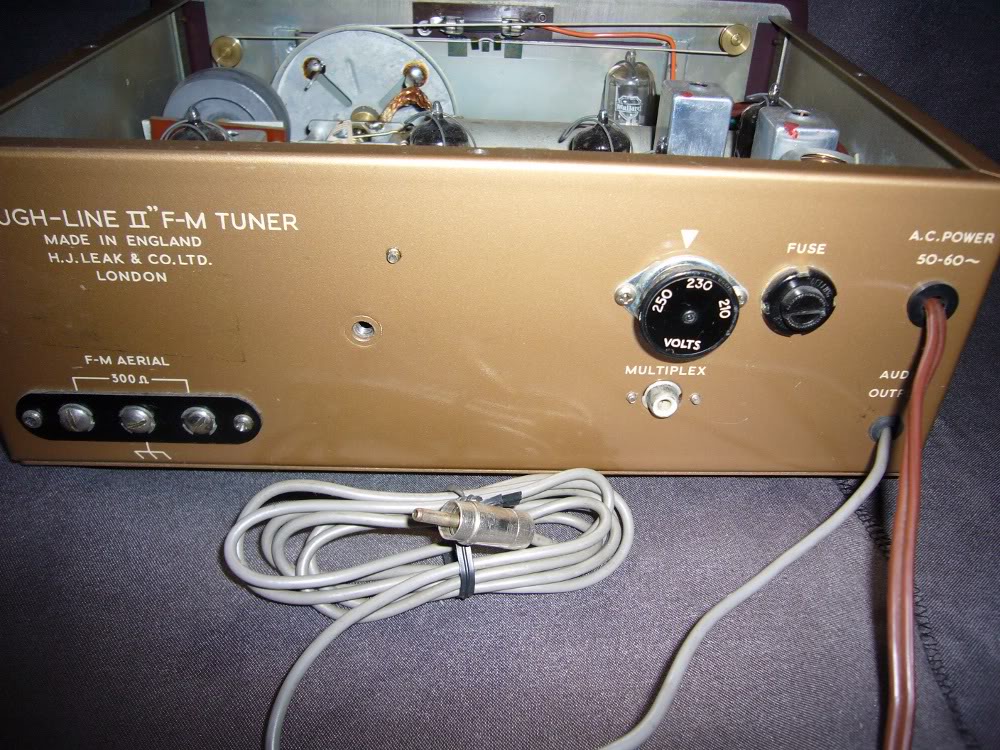
In 1964 the Trough-Line 2 was phased out for the Trough-Line 3 which adopted a new visual style. Silver and black was now the order of the day with the passing of the Art Deco style of earlier models I feel something was lost, at least from a visual stand point. Performance on the other hand improved especially in regard to sensitivity. The earlier Trough-Line tuners are not particularly sensitive in comparison to new tuners, so excellent aerials are needed to provide enough signal to achieve full quieting. This can also be achieved with a good RF amplifier and an aerial of slightly lesser quality. This is the sort of set up that I use with my Trough-Line tuners...living in line of sight of the main FM transmitter also helps. However gain levels must be carefully judged to avoid overloading the tuner.
The Trough-Line 3. Featuring the new black and silver fascia. This unit has a non Leak supplied custom made oak wood sleeve.

The Trough-Line 3 was identical in valve complement to the 2, so in the main the changes were visual only. The 3 continued to offer a multiplex output for hooking up to a stereo decoder, however this was about to change with the introduction of the Trough-Line Stereo in 1966. This introduction came about because of the BBC use of a standard finally which was the same as in America, the GE-Zenith system.
Rear view of the Trough-Line 3. The rear of this unit has been owner modified. An IEC socket has been added, the audio output cable removed and the Multiplex socket upgraded, and the aerial connection has been rather crudely changed to a 75ohm socket

For a number of years Leak had been working on a stereo decoder for the Trough-Line range a Mullard design was tried but didn't work properly so experiments to increase the bandwidth took place. Leak did not want to change the Foster-Seeley discriminator and it was this that limited bandwidth. Eventually a compromise was found, bandwidth was increased but at a loss of sensitivity;not ideal. Ray Whitcombe one of the team working on this problem discovered that substituting the Ecc84 valve for an Ecc88(new at the time) was the solution to the problem. The Ecc88 (a high gain valve designed for use in TV's) allowed the sensitivity to be brought back up.The new decoder (sourced from Phillips, via Mullard) was built into the new tuner and was also offered to older customers as an internal upgrade for older Trough-Line 2/3 tuners.
Trough-Line Stereo. This photo shows an original Leak supplied wood sleeve.

This unit has an inner top and bottom cover in artificial leather (as well as the wood sleeve). I don't know if this was normal or not as this is the first time I have seen this. However the presence of what looks like original screws suggests Leak supplied it this way.
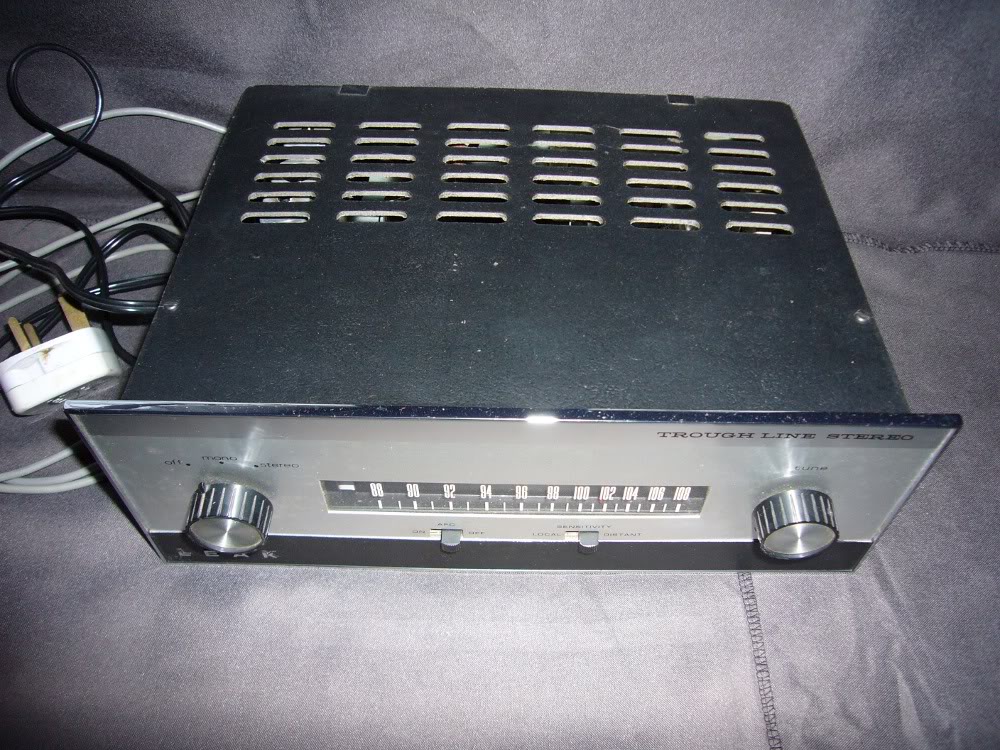
View of the interior.

Rear view. The aerial connection is still via screw connectors and having an on board stereo decoder the multiplex output is gone and audio out is via 2 fixed audio leads terminated with phono plugs.

The Trough-Line 3 and Stereo co-existed with the older design at lower cost (£32) and the newer model as the more high-end model, at higher cost (£47). By 1969 Leak like many companies looked towards the new Solid-State technology and the Trough-Line was phased out in favour of the Stereofetic. This looked similar to the Trough-Line Stereo but had the addition of presets and no valves.I have never heard a Stereofetic, but they are never mentioned (by Radio fans or Audio Magazines) so I must assume (perhaps wrongly) that they are not very good, in comparison to the earlier valve tuners.

For many years the Trough-Line tuner range was a half forgotten product of a by-gone age, until audio enthusiasts and some designers began to rediscover them. Magazines such as Hi-Fi World brought the Trough-Line into the modern world (how I heard about it) and claimed it was as good and better than most modern tuners and even a challenge to the classic Day-Sequera designs. Companies such as EAR introduced a valve decoder to be used with the Trough-Line 2 and 3 and a number of others such as Graham Tricker and One Thing also offered upgrades to fully exploit the Leak tuners. This is all a good thing because a lost gem is now back in the spotlight where it belongs...a true classic of British audio design.
In a future article/review for the Strokes of Genius section I will do a comparison with some modern tuners such as the Revox B260, and we will talk about sound quality. Is the Trough-Line as good as has been claimed...we shall see.
Regards D S D L
(1) Quote from Firsts in High Fidelity by Stephen spicer
Additional photos/material of interest..
Harold Leak and Son

Different finish for the Trough-Line1

The Rodney Hanna Troughline Stereo.
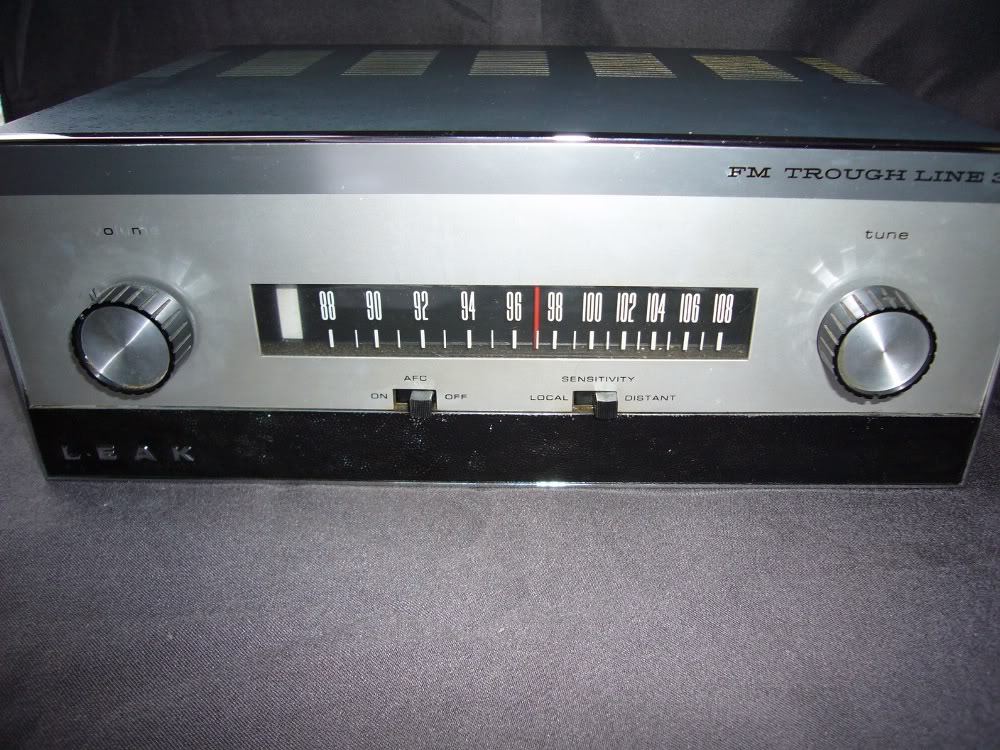
Internal view. Large capacitor at rear right had to be replaced. Above that the new rca audio outs
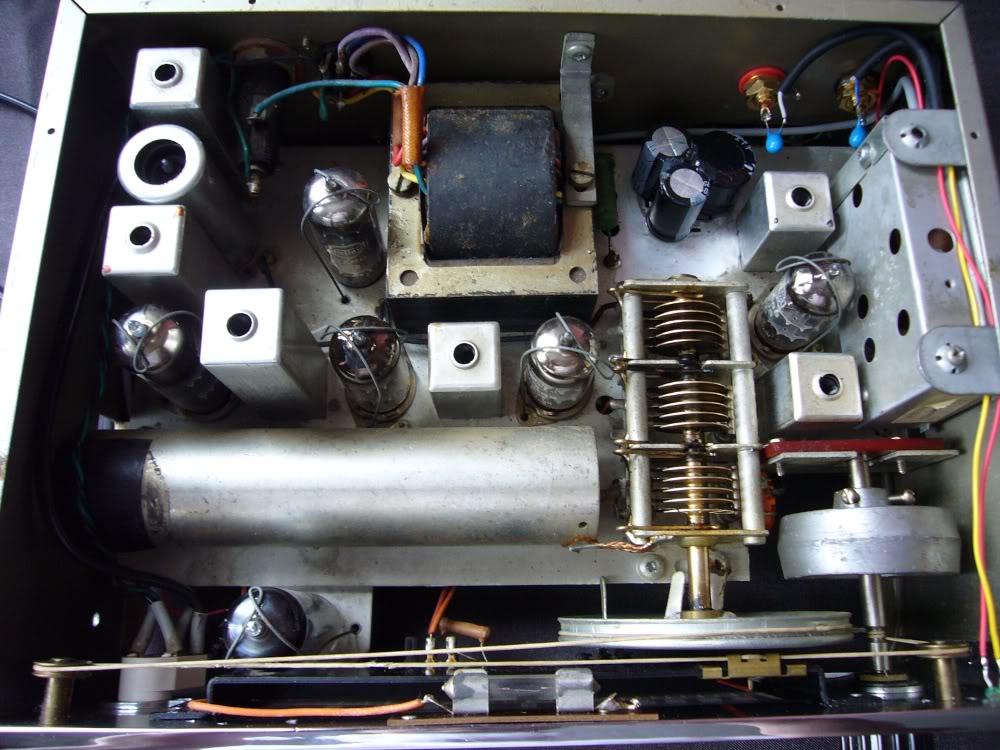
B]Internal view looking to the right side. The metal rectangular box mounted on the inner side houses the new Motorolo stereo decoder.[/B]

View of bottom of tuner
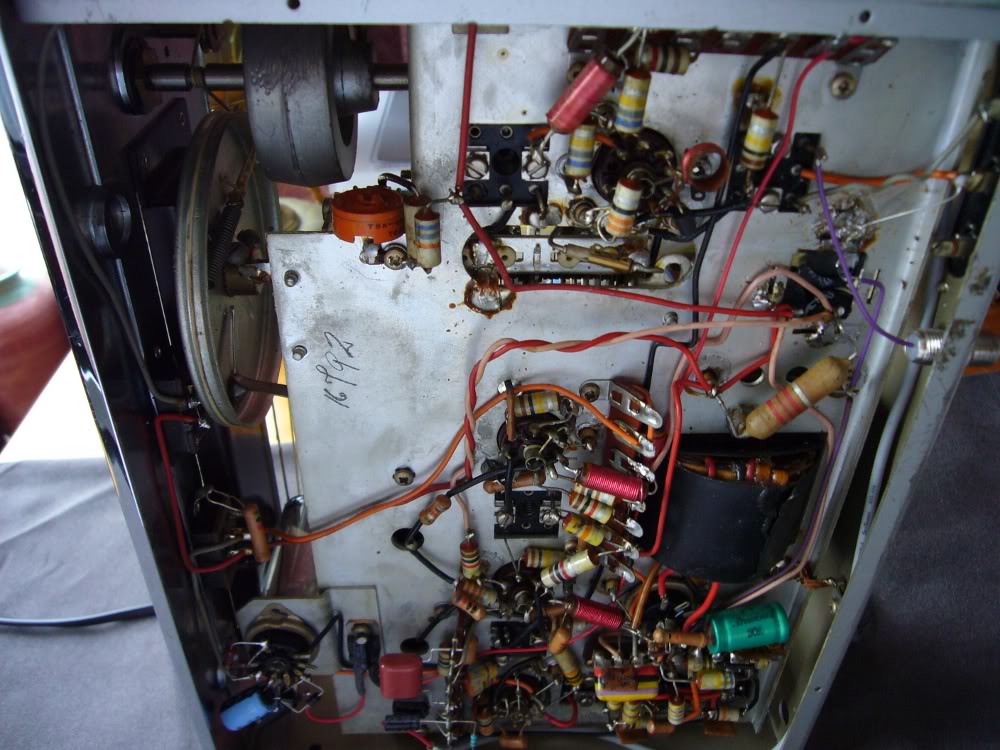
Rear panel with new F connector for aerial connection(original screws connectors still in place). Audio output is now via 2 rca sockets.
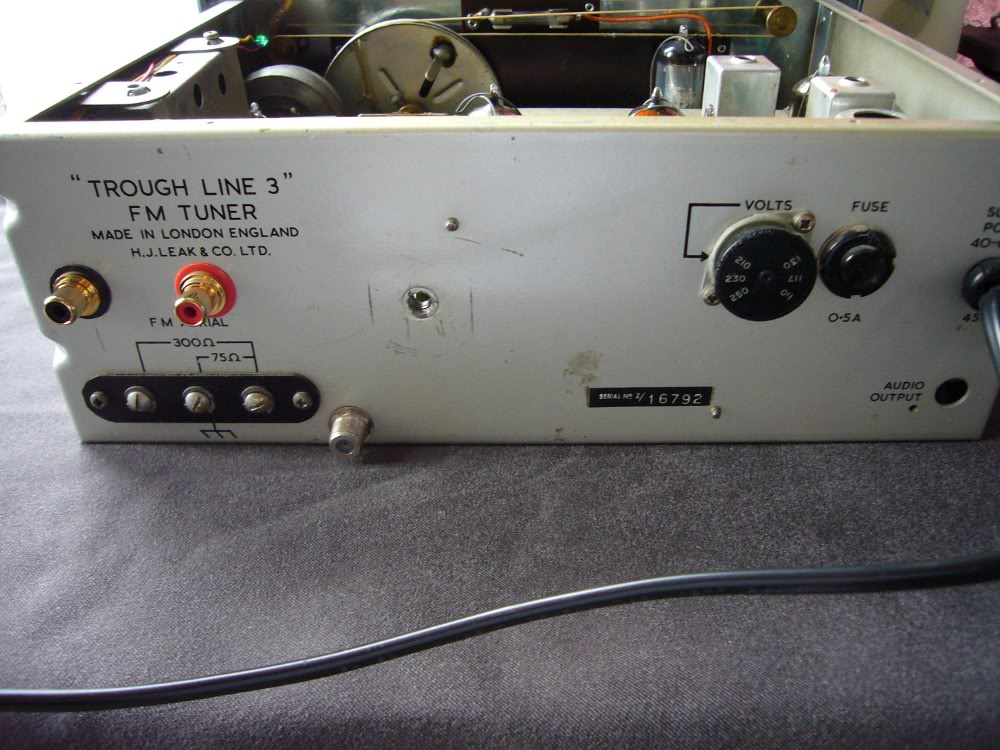
Many Trough-Line tuners were used in cabinets, joint cases with a pre-amplifier as opposed to standalone units. However many were supplied with wood sleeves and later with the Stereo a metal sleeve; this allows the units to be used sitting freely (safely) on a sideboard or on a Hi-Fi rack. A Trough-Line Stereo got recently (from Mike Homar..Thank You) had an original wood sleeve that needed some restoration. You can see in the pictures below how I did this. Black Ash wood stain was used from Cuprinol to bring it back to a nice state of finish. The process took two days as I tried to build the layers up without running. I am fairly happy with it. To create (as new finish) you would have to take wire wool and white spirit to it, possibly even sand paper. I choose to leave the wear and tear visible, and just freshen up the black finish. The addition of 4 rubber feet completed the cosmetic restoration.
Original Leak wood Sleeve for Trough-Line Stereo

Restoration of the original Leak sleeve. Black Ash stain was used which matches the original finish

Metal tight sleeve. Original to the Trough-Line Stereo that became the Rodney Hanna Trough-Line
Front view of this metal sleeve which fits very tightly over the tuner. It would appear Leak offered 2 sleeve choices, wood and metal.

Rear view showing metal upright for screwing the tuner inner to the sleeve. This was done via a single long screw

Custom made oak wood sleeve made for the Trough-Line 3. Sleeve came with unit at time of purchase and is an original owner addition and not a Leak sleeve...very nice though.

Rear view

Useful Links for additional information
http://44bx.com/leak/1968.html Leak Factory Visit etc.
http://44bx.com/leak/decoder.html Leak Stereo Decoder
http://www.dc-daylight.ltd.uk/Valve-...roughline.htmlRepairing Leak Tuners
http://www.hi-fiworld.co.uk/hfw/feat...radecoder.html Review of Trough-Line with EAR Stereo Decoder.
http://www.londonsound.org/leakrepairs.htm Repairing Leak products.
http://www.pinkfishmedia.net/forum/s...ad.php?t=59545 Discussion on upgrades to Leak Trough-Line FM Tuner on PFM
http://www.blackwidowaudio.com/?page_id=11 additional info on Leak Tuners.
Copyright of text and large images 4 to 12 and 16 to 24 belong to NK.
Last edited by Spectral Morn; 21-07-2010 at 17:35.
Regards Neil
 Posting Permissions
Posting Permissions
- You may not post new threads
- You may not post replies
- You may not post attachments
- You may not edit your posts
-
Forum Rules
































 Reply With Quote
Reply With Quote